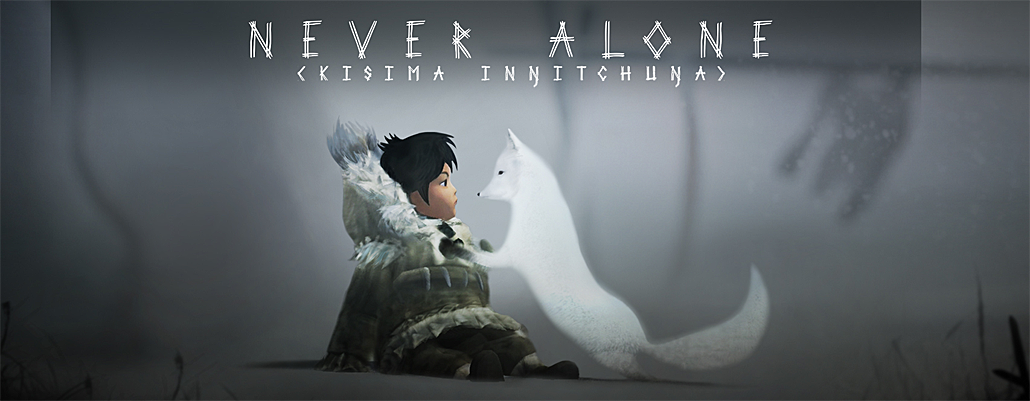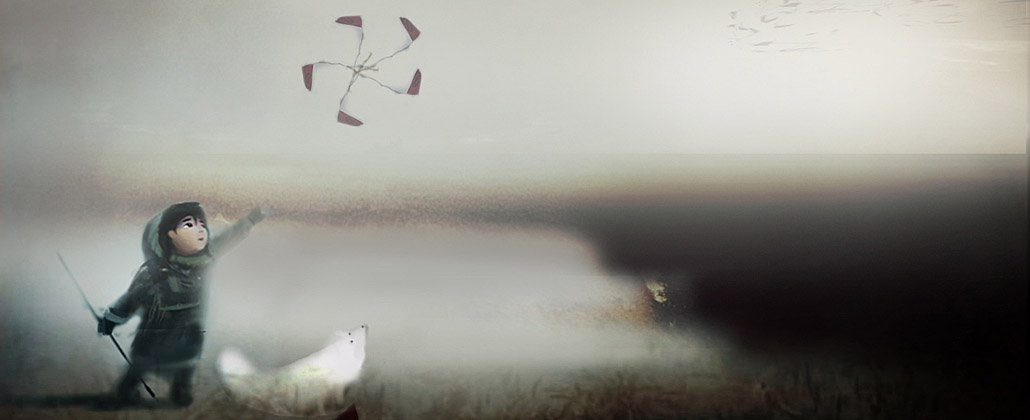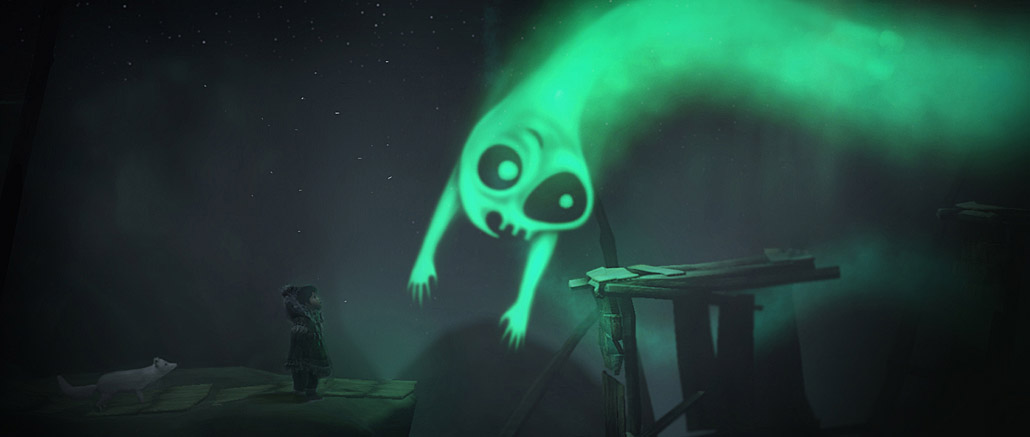
VIDEO: NEVER ALONE TRAILER
Never Alone
Games with a larger mission — to educate or teach — often market themselves as just that: a way to teach kids. But a first-time developer, Upper One Games, is banking that players are willing to embrace games that offer a unique world view while also delivering entertaining gameplay.
Claiming the title of world’s first indigenous-owned game developer, Upper One Games is carving a niche for themselves as leaders in a burgeoning video game genre that purposefully mixes educational storytelling with traditional and commercial gameplay mechanics.
They call them “world games,” and Never Alone, a 2D, puzzle platformer released in November 2014, is their first effort.
Fusing the traditional gameplay with a “living” story steeped in the culture and storytelling tradition of the indigenous Alaskan Inuit tribe, the Iñupiat, Never Alone is the product of a relationship meant to generate art, attention and steady income for the Cook Inlet Tribal Council, an Anchorage-based non-profit providing social services to Alaskan native communities.
Never Alone uses a relentless, malevolent snow storm as both landscape and antagonistic character. In a way, Upper One Games started in a similar environment.

“They were testing us. They wanted to know if we would come up in the middle of a blizzard and minus 30-degree weather. They wanted to see if we would come to Anchorage in the middle of the winter.”
— Alan Gershenfeld, president and co-founder of E-Line Media
World Games Are Born
CITC’s president and CEO, Gloria O’Neill, reached out to Gershenfeld and E-Line Media after hearing him speak at a Games For Change conference. A two-day workshop turned into a three-months planning phase, and the birth of Upper One Games.
In 2012, E-Line built a studio from scratch in Seattle, Wash., with creative director Sean Vesce, with experience working for heavy hitters like Activision, at the helm. CITC gathered a team of Alaska native elders, storytellers and writers who provided Vesce a trove of Iñupiaq stories and values from which he could use as a creative color palette. This partnership provided the framework for Never Alone, and the foundation and philosophy of Upper One Games as an independant developer.
As development on Never Alone progressed, Upper One’s creative staff began evaluating how indigenous and underrepresented cultures were portrayed in other commercial media, particularly world music. The term “world games” as a genre description came, in part, out of that evaluation, and served as a quicker, more accessible shorthand for Upper One’s philosophy of producing game-based cultural storytelling.
“It just kind of stuck. We started using [“world games”] in interviews and internally as we started talking about our road map for future titles. We’re very excited to have helped bring that to life and that others are embracing it as well,” Gershenfeld explains.

The Response
VIDEO: NEVER ALONE GAMEPLAY
Players control Nuna, a young Iñupiaq girl, and Fox, her powder-white animal companion as they traverse a forbidding arctic tundra — also known as Barrow, the largest city of the North Slope above the Arctic Circle — to find and stop the source of a never ending blizzard that threatens to destroy her village.
In Never Alone, nature is a very much a character in addition to a landscape. Through Nuna and Fox’s interdependence — a value CITC espouses as integral to their people’s culture — the character’s work together to overcome obstacles.
The characters must listen and react to the blizzard in order to successfully navigate the world.
According to Gershenfeld, one of the development team’s goals was to weave the story telling elements of the Iñupiat’s traditional never-ending blizzard folktale, and blend it with the gameplay mechanics of a puzzle-platformer.
Never Alone’s design team used the puzzle aspect of the game, overcoming obstacles to progress through the world and the story, to express the independence theme. Nuna is a survivor. A hunter. And she’s honed very specific skills.
“She has thumbs so she can throw a bola, climb ladders and use ropes,” said Lead Game Designer Grant Roberts, “while Fox can scramble up walls, fit into tight spaces, and reveal the world of the helper spirits. They can’t progress through the world without using each others talents and ability to solve puzzles.”
Now that Never Alone has attracted the curiosity, and finances, of a significant subset of curious gamers craving more diverse protagonists and story plot points that haven’t been beat to death, Upper One appears to be in a unique position to lead a burgeoning genre and is already looking for ideas and inspirations centered around other Alaskan native-themed games.
In fact, their vision has gone global. The Alaskan studio is actively seeking more underrepresented cultures from other countries for inspiration, and wants to use their relationship with Iñupiaq leaders as a model for future development projects.
With the number of award nominations Never Alone has received, including Britain’s version of the Oscars in the U.S., it’s easy to understand why.
But in app stores and other distribution platforms full of thousands of developers and their games struggling for attention in a sea of competition, toeing outside the mainstream is a risk.
Gershenfeld says those kinds of decisions are certainly challenging, but should be welcomed rather than avoided.
“If somebody genuinely wants to explore a new perspective, that’s actually a great differentiator,” Gershenfeld said. “It’s not something to overcome or apologize for, but something to embrace. It’s truly powerful, authentic, and, in fact, the secret sauce, as long as it aligns with great gameplay, and the team has the skills to develop a fun game within whatever platform and genre they’re working in.”
Gershenfeld believes these kinds of stories don’t exist solely in niche markets anymore. He says mainstream tastes are starting to shift. Never Alone has sold hundreds of thousands of digital units and physical copies since it’s release.

“There are very good games exploring very diverse, very rich themes, and they’re all selling units. Clearly there’s a demand, and it shouldn’t be a surprise. The idea of finding themes that anchor mechanics reinforces the richness of cultural storytelling in games.”
— Gershenfeld on the diversity of games
What’s Next?
Never Alone’s art director Dima Veryovka — a Ukrainian native who holds a master’s degree in Fine Arts and Architectural Design from the Imperial Academy of Arts in Saint Petersburg, Russia — studied indigenous cultures, and points to Inuit art and mythology as a major influence in much of his earliest art projects and sculptures.
Using Unity, a cross-platform 3D game development engine, Vesce, Veryovka, and the rest of Upper One development took ideas from the Inuit writers and elders, and built a game around them.
Never Alone — or Kisima Ingitchuna as it’s called in Iñupiaq, — has received mostly positive reviews from many mainstream game and tech review sites, including Forbes, Polygon, and Joystiq.
Gershenfeld, who’s also a former Activision executive, believes that Never Alone’s biggest success was in making it a genuine native game that other could play.
“The game is in Iñupiaq with English subtitles, and that’s never been done in a commercial video game, and it’s being experience by millions of people through trailers, YouTube plays and Twitch.tvs,” which, Gershenfeld acknowledged, is a big responsibility.
Developers expressed much of the Iñupiaq storytelling elements through 26 unlockable video mini-documentaries voiced by actual tribal members.
“We were unsure about the cultural insights. There’s a lot of concern about linear video in games. We shot about 60 hours of footage which we thought was powerful, but were very nervous about how that would be received,” Gershenfeld said, adding that players have the option to skip the videos.
“Those cultural videos, they’re literally breathtaking,” said Roberts, “but we wanted to weave those storytelling concepts together with the gameplay even more tightly without making them feel too didactic or like sitting in a desk in school.”
Thinking back on that design challenge, Roberts said nobody is more critical than the Upper One team.
“For example, in a level set in a coastal village, home of the ‘Aurora Borealis people’,” Roberts explained, “we wanted to introduce you to the backstory of those people by having the denizens flee in terror in front of you without having to just say it. So we know there are better ways, and we are big believers of ‘Show. Don’t tell.’”
One major site, Gamespot, was particularly critical of the Never Alone’s gameplay and a detrimental divide between the storytelling elements. They felt the “sluggish controls” required to navigate Nuna’s jumps over icey chasms and though arctic wind, were often too clumsy to overcome.
But others felt the gameplay, however shaky it might have been at times, was overshadowed by Never Alone’s unique ability to educate without being a bore.
In a review for the popular gaming website Kotaku, writer Evan Narcisse noted how the traditional Iñupiaq stories of surviving within nature dictated the player’s navigation through the world and affected gameplay in interesting ways.
“Winds that can blow you off platforms must be resisted by hunkering down,” Narcisse writes, “and scary, clutching ghost versions of the Aurora Borealis are also metaphors for how suddenly the cold can snatch life away without proper precaution.”
For Narcisse, those metaphors and their richness were enough to elevate the game above whatever gameplay issues it may have, and he selected Never Alone as one of his top ten games of 2014.
Upper One released Never Alone across traditional console and PC platforms, but Gershenfeld said they’ll announce development for other platforms, like iOS and Android, possibly as soon as the 2015 Game Developers Conference in March. They’ve also released a version of the game for Mac users, as well as a musical soundtrack, in late February.
And the potential for distribution goes even further. Some universities have asked Upper One for permission to include Never Alone in culture-in-media-type academic courses. Even though Upper One didn’t design the game to fulfill an educational role per se, there’s no question that Upper One, and E-Line Media, see opportunities for the game within education.
As a games publisher, E-line Media cut its teeth with game-based learning platforms. Their relationship with cloud-based educational gaming platforms like MinecraftEdu and Gamestar Mechanic, gives E-Line a presence in more than 10,000 schools. It’s a market they understand.
“We’ve tuned [Never Alone] to be a commercial game, but since we support game-based learning in schools, and with our Pathways line of products, we will definitely support institutions to use the game,” Gershenfeld said.
Gershenfeld definitely sees the possibility for something like “Never Alone Edu,” and believes Upper One and E-Line’s partnership will continue to refine and develop gaming experiences that are both an educational and a commercial success.
“The cutting room floor is full of cultural stories that would have made for great levels,” said lead designer Roberts. “We want to keep telling more stories with Nuna and Fox, maybe set in Alaska. You’ll see more things from Never Alone in 2015.”
